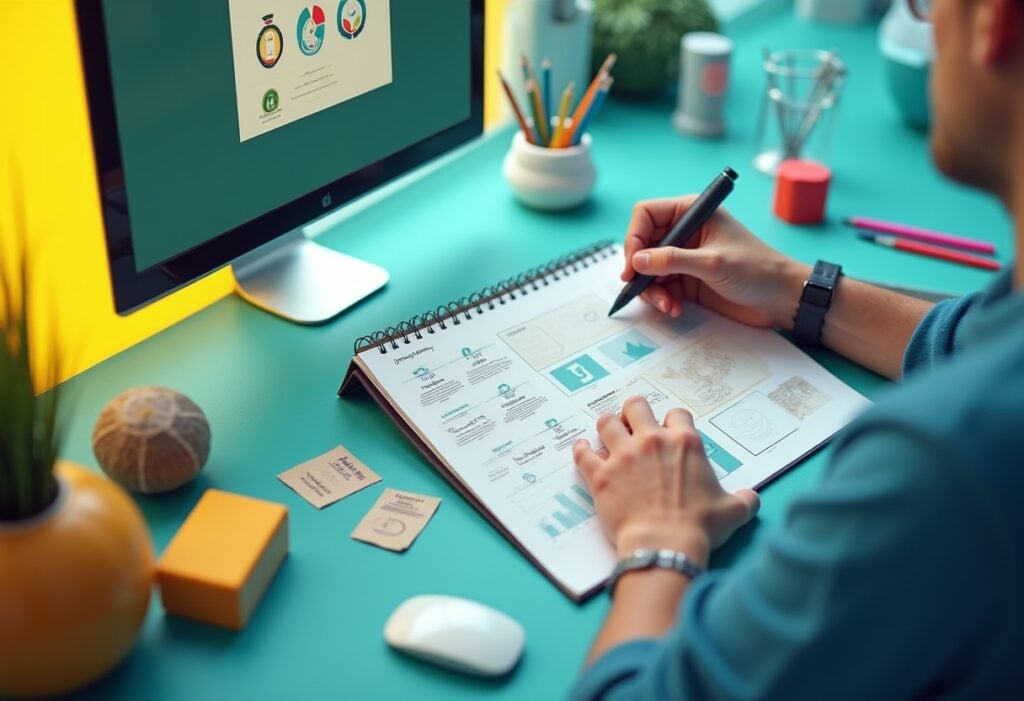How to increase conversion rate: Quick tips
- Provide easily accessible contact info
- Use high quality imagery
- Design for mobile
- Use in line CTAs
- Simplify your forms
- Consider social proof
- Try a live chat
- Add videos
- Consider microinteractions
- Consider using AI powered tools
What does website conversion mean?
I am sure you have heard the phrase ‘website conversion rate’ being bounced around the office or at networking events, but what does it actually mean? Essentially it is the measure of how good your website is at getting your users to do what you want them to. Whether that be get in touch, request a brochure or buy your products.
Having a good conversion rate should be the top priority for any website; after all if you are going to invest time, money and resources into a site then you want it to deliver results. If your website has a poor conversion rate, alarm bells should be ringing. Ultimately your website should be generating leads and helping you to close sales and to help you in the process, here we share our tips on how to improve website conversions.
What is conversion rate optimisation?
Conversion rate optimisation is the practice of increasing the number of users who perform a desired action on a website. This may include actions such as purchasing a products, adding a product to cart or filling in a form for example.
Conversion rate optimisation process:
If you’d like some quick tips on improving your conversation rate optimisation process, we’d recommend considering the following steps:
- Identify goals and objectives
- Analyse your current pages
- Understand the current consumer journey
- Gather user data
- Develop testing ideas for improvement
- Conduct tests
- Analyse results
- Adapt the approach
What is a good website conversion rate?
A good website conversion rate is generally between 2-5%, however this can vary by industry.
Factors that may be damaging your conversion rate:
We have compiled a sample list below of the ways in which you could be damaging your conversion rate:
1. Confusing navigation
At the end of the day any visitor to your site has an initial goal that they would like to fulfil (also known as user intent), whether that be finding your contact information or purchasing a product. Some websites are set up to provide information and this can also be categorised as a user intent and have an associated conversion goal. Users want to be able to complete tasks with as little hassle as possible. Having an inconsistent navigation can confuse the user and in turn makes them less likely to convert on your website.
Two quick factors to look out for are as follows:
- Are your basic navigational elements like buttons and pagination styles the same? If not we would recommend no more than two different styles of clickable buttons.
- Does your menu use the same format across all pages? Menus should be really easy to use and consistent so that the user is able to navigate the site with consummate ease.
Remember that the user’s experience on your site will have a knock on effect as to how they interact with and trust your brand.
2. Hard to read and irrelevant copy
Have a look through your website and answer the following questions:
- Is the text easy to read? You should look at a combination of factors, including the size of the font, the colour of the text and the line spacing. It goes without saying that users get frustrated and discouraged if the copy on your site is too difficult to read. For more information on user friendly text have a look at our accessibility post.
- Is the wording easy to understand? What is the assumed level of knowledge for the user? If your content is heavy with industry jargon yet your average user is just learning about the subject, you may find that they feel alienated by your content.
- Is your copy written with your audience in mind? Your audience not only affects the required style of your written content but also (and critically) the amount of text, images or video needed to be valuable to them.
3. Too many distractions
“I would like a super clean, clear website” – something that we hear from almost everyone that we sit with to take a website brief… and for good reason. People want the website to show them critical information in a clear and concise manner.
They don’t want to be endlessly searching to find what they want. If your website design doesn’t have a clear site hierarchy, menu structure and call to actions but instead is cluttered with distracting elements such as adverts, large bold image banners or conflicting call to actions, this will have a negative impact on their user experience. In turn it will result in a lower conversion rate.
Accordingly, this joint study by Harvard, University of Maryland, and University of Colorado, found that websites with a high number of elements and a complex design had lower appeal to users:
“Complexity in terms of higher numbers of elements on websites lowers ratings of appeal”
Put simply the more conflicting visuals on a page the more brain power or ‘Cognitive load’ is imposed on the user. Therefore the more likely they are to miss important information, get overwhelmed and abandoned the task. A hugely overused but fantastic example of minimal elements is that of Apple, both for their website and their products.
How to improve your website conversion rate
Below are eight essential actions you can implement now to help increase your CRO.
1. Provide easily accessible contact info
Ensuring that your phone number and email address are easy to find is essential. It gives visitors confidence that you are easily contactable if they should have any questions. Hubspot released a study showing that more than 50% of website users expect to find contact information on the homepage of a website.
2. Use high quality imagery
Make the most of your visual assets. Using low res, misleading or low quality 90’s style stock imagery can have a very negative impact, not only on user experience but also CRO. Ensure that you use the best imagery possible.
Pro tip: where possible using photo of humans can increase the visitors trust in your brand, as it makes the business more personable. Another cool trick to implement is using the Eye Gaze within the photos to draw attention to a CTA or particular product. For more information check out our post on the importance of imagery.
3. Design for Mobile
If your site isn’t mobile friendly it will have far reaching effects on your website’s ability to both attract and convert visitors. Responsive sites are great but having a site specifically designed for mobile will further help improve your conversion rate via a device that accounts for more than half of all internet traffic.
4. Use in line CTAs
One tip that is super easy to implement is to start including CTAs within your blog copy. This takes advantage of visitors that are already interested enough to read the post. Most blogs utilise inline links within the article but why not try testing out some CTAs to other areas of your site in your next post?
5. Simplify your forms
We don’t know anybody who actually enjoys filling out forms. If you do, we would love to know why! To improve the success rate of your forms consider the following:
- Reducing the number of fields
- Making non essential fields optional
- Consider removing the phone number field
BliVakker.no performed A/B tests on their registration forms and saw an 11% rise in registrations after reducing the amount of fields within the form.
For more information check out our posts on how to create lead capture forms and landing page optimisation.
6. Social proof
Social proofing ranges from client testimonials, reviews, case studies, ‘trusted by/featured in’ logos and customer data (x users actively use…). You are trying to win the visitors trust by leading them to ‘follow the herd’ using Normative Social Influence. Have a brainstorm internally on how you can utilise your current network, or online tools to add social proofing to your web design process.
7. Try live chat
Integrating a live chat function to your website has been proven to increase CRO; Intuit (QuickBooks) saw a 211% increase rate after implementing a proactive chat. Try testing the function on different pages of your site – it provides direct access to bespoke information for your visitors so is understandably popular!
8. Videos
Video isn’t exploding, it already has. I am sure a lot of you are professionals at series binges or open every vaguely interesting video on your facebook feed. Did you know our brains process video 60,000 times faster than text? By adding product videos, intro videos, testimonials and other types of videos it is an easy way of relaying information to your visitors and provides a variety of content types on your site.
9. Consider microinteractions
Microinteractions are often an overlooked element of website design, but these important features can help make the difference in your website conversion rate, by improving user experience.
10. Consider using AI powered tools
Consider using AI powered tools to analyse user interactions, identify issues and suggest improvements.
Conversion rate optimisation (CRO) FAQs
What are the main elements of conversion rate optimisation?
The main elements of conversion rate optimisation include research, user experience (UX), user behaviour, A/B testing and personalisation.
Is CRO worth it?
Yes, optimising your website content with the aim of driving conversions is worth it. Small changes can have a large impact on conversion rates.
Is conversion rate a good KPI?
Conversion rate is a crucial KPI for many marketing campaigns. Looking at conversion rates can help you understand ROI, areas of overspending, pain points, and can help to inform strategy.
Next Steps
We hope the above tips give you a quick insight into some simple ways to improve your CRO.
Tracking conversions and understanding how your website converts is the next stage in the process. A platform that makes tracking user flow easy is Hotjar. I warn you now though – it can be very addictive watching videos of real user sessions on your site! Setting up funnels on Hotjar will enable you to gain real insights into your real life conversion funnels. We will be going into more detail on A/B testing and using tracking platforms like Google Analytics and Hotjar in other upcoming blog posts, so keep your eyes peeled.
Yellowball is a London Based SEO & Web Design Agency!









